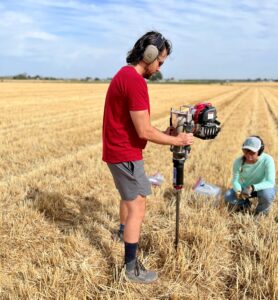
There are currently not enough people available to accurately sample soil carbon in the continental US, beyond the USDA-NRCS (United States Department of Agriculture – Natural Resource Conservation Service) staff. A qualified individual is a person that is reputable and competent for soil sampling in lieu of a NRCS staff.
The goal of the Soil CoRE team is to train qualified individuals in each of the 13 Western states to be available to perform soil sampling for a producer (grower, rancher, forester) who would like to participate in the USDA-NRCS CEMA 221: Soil Stock Carbon Monitoring program. A qualified individual is defined as a person with a background in agriculture (detailed in the “Becoming a QI section) that completes a virtual and hands-on training about soil carbon sampling, to measure soil organic carbon storage before and after a NRCS conservation practice.
This page provides information for anyone interested in becoming a qualified individual.
Why Should I Become a Qualified Individual
Develop Professionally
- Experience with consulting and field work for stakeholders
- Verified to be an NRCS Qualified Individual
- Payment for your work
Serve your Community
- Be a source of soil health knowledge for your community
- Diversify community stewardship to build up healthy soils
Sustain for Future Generations
- Build soil health for the next generation of producers
- Expand agricultural networks
- Create resilient agricultural production systems
- Reduce the agricultural carbon footprint
- Help to build a national carbon dataset
Select a tab to learn more:
As a qualified individual, can you tell me the overall responsibilities of a QI in CEMA 221?
The purpose of the CEMA 221 is to help measure and sequester carbon in the soil to combat climate change. Soil has twice the capacity to store carbon than the atmosphere. Conservation practices implemented by producers can help to sequester (store) the carbon. Your role is to help measure how much is sequestered using different conservation practices.
What is CEMA 221?
CEMA 221 is the measurement of Carbon in a producer’s soil before and after they implement a conservation practice. To become a Qualified Individual requires multiple steps, outlined in the “How do I become a QI” tab. If you interested in the work that is required of a QI, please read below.
Before you are involved
The producer works with a NRCS conservation planner to identify environmental issues on their land, and they apply for the appropriate conservation practices through financial assisted programs (EQIP, CSP). If the producer is selected for a financial assisted program, they will create a contract with the NRCS to complete the conservation practice within an allotted time.
The producer will have an additional contract that outlines CEMA 221 measurements before and after their conservation practice. This is where your involvement as the qualified individual begins.
- Pre-work Conference. Once the producer and NRCS conservation planner have identified the conservation practices that will be implemented in the producer’s field, then you will be invited to join the pre-work conference. You will meet with the NRCS conservation planner and the producer to determine the type of soil sampling that should be completed on their land. You will review the objectives of the chosen conservation practice, and you will determine the dates you will sample the soil.
- Sample. On the contracted dates, you will complete the soil sample on the producer’s property. The appropriate procedure for sampling for CEMA 221 will be taught through out certification.
- Soil samples submitted to the Lab. Once the producer’s land is sampled, you will need to send the soil samples to be analyzed for carbon content. You must wait for the results to complete the CEMA 221 paperwork.
- Complete CEMA 221 paperwork. The results from the lab will be sent back to you. You will complete soil calculations and check the 3 sections you must complete before submitting to NRCS.
- Paperwork submitted to NRCS. All sections and field paperwork must be completed and reviewed by the NRCS staff.
- Final review by NRCS State Agronomist. The paperwork will be reviewed by the State Agronomist.
- Reimbursement. Depending on your contract with the producer, you will receive reimbursement for your work.
- Repeat. Complete steps 1-7 in 3-5 years for post Carbon soil sample.